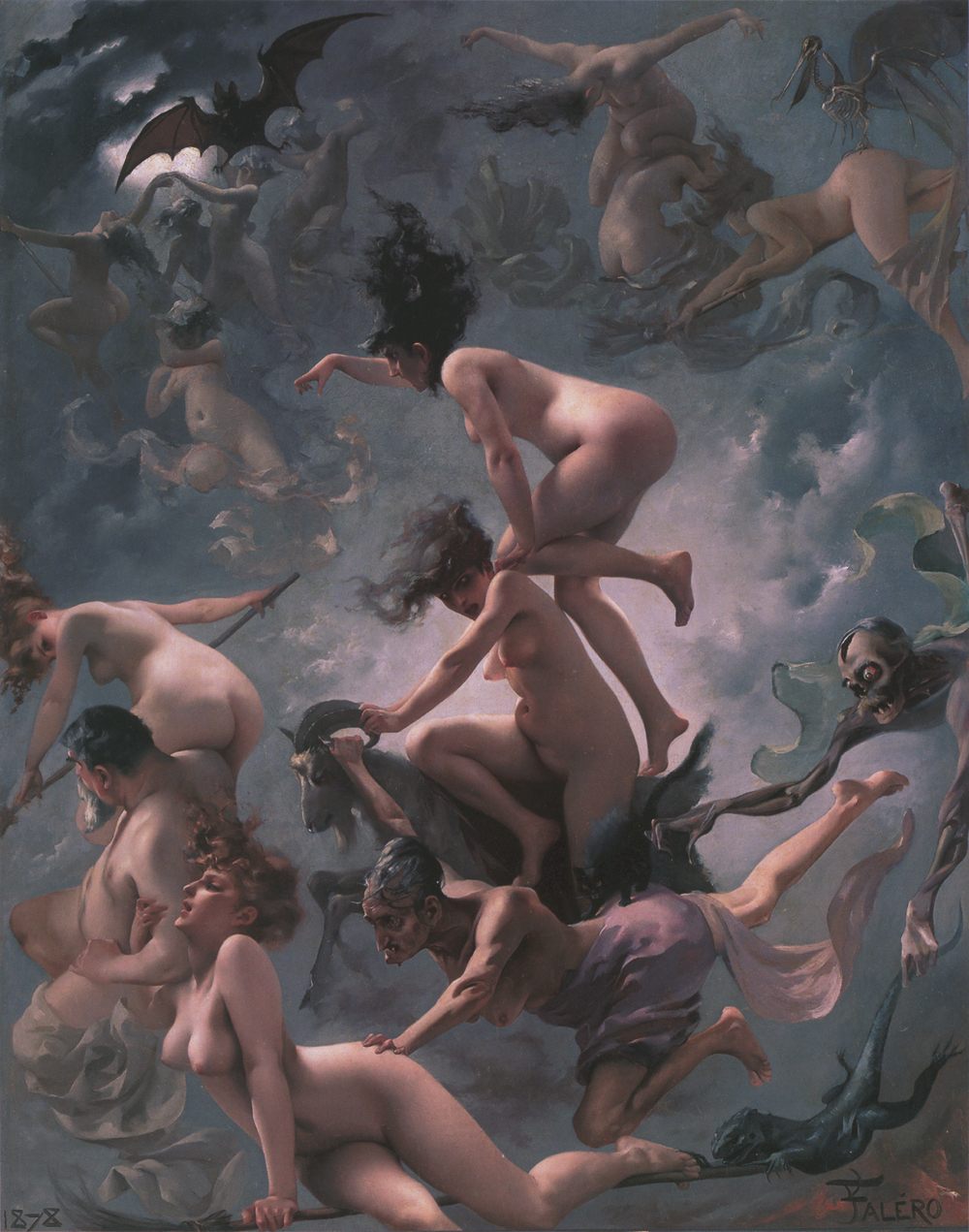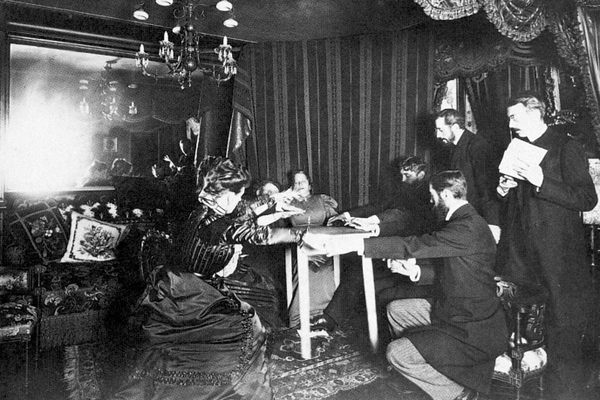Sex, Drugs, and Broomsticks: The Origins of the Iconic Witch
Why do witches ride brooms? Buckle up.
 Luis Ricardo Falero, “The Witches’ Sabbath” (1880), oil on canvas (via Wikimedia)
Luis Ricardo Falero, “The Witches’ Sabbath” (1880), oil on canvas (via Wikimedia)
Witches were almost always portrayed naked until the 1900s.
In rifleing the closet of the ladie, they found a pipe of oyntment, wherewith she greased a staffe, upon which she ambled and galloped through thick and thin.
— 1324 investigation of suspected witch Lady Alice Kyteler.
Silhouetted against the moon, pointy hat pushed back by the wind, the witch on her magic broomstick is an iconic image, ubiquitous during the Halloween season. While the image can be found pasted in elementary schools throughout America, the story of why witches look the way they do, and why they fly on broomsticks, is a racier, lesser-known tale. What follows is mildly NSFW.
For a long time the common answer to the question of why witches flew on broomsticks was relatively straightforward if a bit broad. The broom was a symbol of female domesticity, yet the broom was also phallic, so riding on one was a symbol of female sexuality, thus femininity and domesticity gone wild. Scary for any patriarch! It wasn’t just women, however. The first known reference to witches flying on broomsticks was confessed by a suspected male witch, Guillaume Edelin of Saint-Germain-en-Laye near Paris, while he was being tortured in 1453.
There was also once a common pagan fertility ritual where poles, pitchforks, and brooms (basically, phallic objects in general) were piloted through the fields with people jumping as high as they could to entice the crops to grow to that height. (A tradition related to the jumping of the broom wedding traditions.) Reginald Scot’s book, The Discoverie of Witchcraft, published in 1584, described these festivals as such:
At these magical assemblies, the witches never failed to dance; and in their dance they sing these words, ‘Har, har, divell divell, dance here dance here, plaie here plaie here, Sabbath, Sabbath.’ And whiles they sing and dance, ever one hath a broom in her hand, and holdeth it up aloft.
Combine pagans, brooms, phallic fertility symbols, and jumping into the air, and you have all the ingredients you need for the myth of the flying witch. But there is another possibility, a more literal and much saucier origin story of the witches riding their broomsticks.
 Francisco Goya, “Witches’ Sabbath (The Great He-Goat)” (1821-1823), oil on canvas
Francisco Goya, “Witches’ Sabbath (The Great He-Goat)” (1821-1823), oil on canvas
(via Wikimedia)
Besides riding on broomsticks, the second most iconic image of a witch is of old hags brewing up a witches brew, the old “double, double toil and trouble” of Shakespeare’s Macbeth, written in the early 1600s. But just what were these witches actually brewing up? Well, around the same time as the first reports of witches flying broomsticks is the mention of “flying ointments.”
The use of hallucinogenic plants for shamanic purposes goes back to prehistory. In medieval Europe there were a number of hallucinogenic plants in fairly easy supply. First among these was the rye mold containing ergot fungi. With effects on humans similar to LSD, ergot was a powerful hallucinogen. Among other readily accessible hallucinogenic plants were henbane, deadly nightshade, mandrake, and, according to Johann Weyer in his 1563 Praestigiis Daemonum, these were all principal ingredients in any witch’s “flying ointment.”
Hans Baldung Grien or Grün, “Witches’ Sabbath” (1510), woodcut (via Wikimedia)
However there is a problem with drinking such a potent witches brew, chief among them that it can make the drinker quite sick, and could even be deadly. But among the other ways to ingest a hallucinogenic drug besides swallowing it is through the mucous membranes, such as under the armpits, through the anus, or for women, through the mucous membranes of their vaginas. And how might such a ointment be best applied to those delicate mucous membranes? From the 15th century records of Jordanes de Bergamo:
But the vulgar believe, and the witches confess, that on certain days or nights they anoint a staff and ride on it to the appointed place or anoint themselves under the arms and in other hairy places.
An early 1600s illustration of a French witch preparing to fly, ointment in hand, from the Museum of Witchcraft in Bayonne, France.
Even more telling is a quote from a 1324 investigation of suspected witch Alice Kyteler:
In rifleing the closet of the ladie, they found a pipe of oyntment, wherewith she greased a staffe, upon which she ambled and galloped through thick and thin.
In 1477, Antoine Rose, known as the Witch of Savoy, confessed, again under torture, that “the Devil, whose name was Robinet, was a dark man who spoke in a hoarse voice. Kissing Robinet’s foot in homage, she renounced God and the Christian faith. He put his mark on her, on the little finger of her left hand, and gave her a stick, 18 inches long, and a pot of ointment. She used to smear the ointment on the stick, put it between her legs and say ‘Go, in the name of the Devil, go!’”
 Albert Joseph Pénot, “Départ pour le Sabbat” (1910) (via Wikimedia)
Albert Joseph Pénot, “Départ pour le Sabbat” (1910) (via Wikimedia)
Once this had been done, the effects of the “flying ointment” would begin to take effect. Brewed up from such things as deadly nightshade, wolfsbane, henbane, and hemlock, often in a base of animal fat, the ingredients would have been potent indeed. And the effect of this brew, this tropane alkaloid (due to the nightshade and henbane) hallucinogen? As relayed in a 1966 description by Gustav Schenk:
Each part of my body seemed to be going off on its own, and I was seized with the fear that I was falling apart. At the same time I experienced an intoxicating sensation of flying. […] I soared where my hallucinations — the clouds, the lowering sky, herds of beasts, falling leaves […] billowing streamers of steam and rivers of molten metal — were swirling along.
 Luis Ricardo Falero, “Witches Going to Their Sabbath (or The Departure of the Witches)” (1878), oil on canvas (via Wikimedia)
Luis Ricardo Falero, “Witches Going to Their Sabbath (or The Departure of the Witches)” (1878), oil on canvas (via Wikimedia)
And why the fixation on the broomstick and not another object? Wouldn’t a broomstick be a bit… unwieldy? One such explanation is that the herbs used in such a preparation would have been kept in small broom-like bundles know as whisks, which may have been boiled whole in oil, both releasing the active ingredients from the whisk and thus soaking the handle with the concoction. The use of this whisk, stick, or broom coated in the oil would have done the trick quite nicely, along with some added personal benefits.
From the viewpoint of our modern times, such drug use and self pleasure are not such shocking acts, but are in fact liberating, but at the time a woman choosing to do what she wished with her own body or mind was so unthinkable as to be synonymous with the devil himself. Many women were tortured and killed because they dared to explore such personal liberties.
Let us be glad those times are (mostly) past us. In the words of Scottish “witch” Antoine Rose’, who is believed to not have been killed but disappeared after her trial, jump on your broomstick and “Go, in the name of the Devil, go!”
Hans Baldung Grien’s 16th century drawing of Witches mid “flight.”
Albrecht Dürer, “The Four Witches” (1497), engraving (via Wikimedia)
Francisco Goya, “Witches Flight” (1797-1798) (via Wikimedia)
LEARN MORE ABOUT THE WONDERFUL WORLD OF WITCHES:
THE MUSEUM OF WITCHCRAFT, Boscastle, England
THE MUSEUM OF ICELANDIC SORCERY & WITCHCRAFT, Hólmavík, Iceland
YORK WITCH GRAVE, York, Maine
THE WITCH HOUSE OF SALEM, Salem, Massachusetts
This article originally appeared as part of Atlas Obscura’s 31 Days of Halloween in 2013.










Follow us on Twitter to get the latest on the world's hidden wonders.
Like us on Facebook to get the latest on the world's hidden wonders.
Follow us on Twitter Like us on Facebook